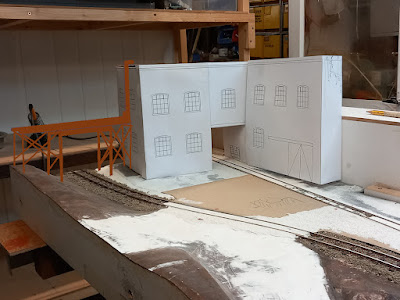Finish the wiring for the new section and test new section switch.
Review how the new section can be used.
Review a new building design.
Laurence away today, so just two again.
The full layout (less fiddleyard) was erected and the control panels and looms fitted, but not powered up. All of the mods carried out the previous week were physically checked again, with an emphasis on whether the 19vDC feeds (for trackside features) had been reconnected correctly. The new section was tested from both panels with a continuity meter and once satisfied, the power was switched on.
Firstly, a new track break was made adjacent to the signal and then the feed from the new switch was connected to the new section. The break position wasn't the first option - something half-way was initially considered, but the chosen position allows a train (controlled by 'next-door') to run right up to the signal - a natural place to stop. A main panel operator can easily take control of the empty section if more room is required for a shunting manoeuvre further along the station road.
Geoff moved on to infilling the rear face of the Masons boards, where the backscene will eventually be fitted. Strips of 9mm plywood were prepared and screwed in place. It was decided to fabricate aluminium strip posts to fit at the ends of the tunnel construction, to reduce accidental damage while erecting/transporting the boards.
Stephen had prepared some paper overlays of the new masons building facades, and now fitted them to the existing cardboard mock-up. It immediately looked better. The idea is to form not an entrance into the building, but a tunnel through to a rear yard, which would allow a wider range of engines to be used. With obscuring the mainline fiddleyard in mind, the very first idea used a stone archway conveying spoil to the tips beyond in small wagons. This has latterly been overtaken by piped waste being pumped over the track. The support structure will have to provide a visual break so solid frames will have to be investigated.



